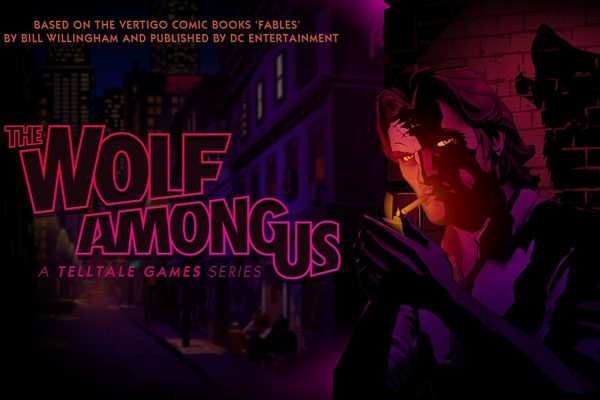The Wolf Among Us: “Faith” and a Little Luck

October 30, 2013
The concept of an “episodic” game is that a game normally released in one fell swoop at $60 is instead released TV-style, in “episodes”, for a cheaper total price, and they can be bought one at a time for an even cheaper price. This format is most popular with point-and-click adventure games, and the current masters of it are Telltale Games, late of The Walking Dead: Season 1 and Poker Night 2. Telltale have made a business of translating non-game IPs into games, having made games out The Walking Dead, Back to the Future, and Jurassic Park, among others. With The Wolf Among Us, Telltale has adapted Fables, a comic by Bill Willingham focusing on fairy tale characters exiled to New York City, to the medium.
In The Wolf Among Us, players control Bigby Wolf, the sheriff of Fabletown (a covert community of Fables in New York City), who also happens to be the Big Bad Wolf of folklore (although this isn’t your grandma’s Big Bad Wolf, having ripped apart entire armies like it was a walk in the park), and has gained the ability to take human form. One of the game’s most interesting dilemmas is whether you play nice with other Fables to gain some trust and respect or use violence to get things done. Each choice you make is important, and each dialogue choice brings out the truly fantastic writing Telltale is known for, along with far-above-par voice acting. Moreover, each of the choices felt substantial, as if every single one had a major impact on the game, even when they didn’t. Adding to the tension is the timer you have on each decision, forcing you to think fast instead of deliberate and slow the game’s pace. Diminishing the impact, however, are the redundant pop-ups that appear after you make a dialogue choice.
Each time the game tells the player it will remember your choice. Of course it will.
Warning: Minor spoilers ahead.
The story is a prequel set in the 1980s, and kicks off with Bigby investigating a disturbance with Donkeyskin Girl, or “Faith” (and yes, that’s actually a fairy tale, first published in France in the 1600s) and the Woodsman. The girl is later found not just dead, but decapitated, and a hunt ensues for the killer. The game is afoot, but not complete, so there are dangling threads and loose ends and the like, but they’re well written enough to keep your interest, although the ending to the episode….was needless. Yes, I understand the attempt to raise the stakes and give a bit of dimension and (more) gravity to the situation, I just don’t think Telltale should have gone about it the way they did. A more…*ahem* minor character would’ve sufficed.
The gameplay is that which you’d expect in a point-and-click adventure game, with players controlling Bigby as they walk around various crimes scenes interacting with objects denoted by translucent white circles. Thankfully, Telltale has made some improvements in the gameplay compared to their previous games, such as making Bigby not control like a brick with legs, but most of these are confined to the combat, which is still entirely quick-time event based. Normally, quick-time events are the bane of a gamer’s existence, requiring really, really quick reaction time at the points (and situation, and games) where you’d least expect them, but they work rather well here, giving combat a flow not seen in even Telltale’s earlier games.
There is one major improvement to the non-combat gameplay: exploring the areas is actually worth it. In The Walking Dead: Season 1, I knew that a zombie was going to pop out or something was going to transpire to make things go south. However, in The Wolf Among Us (and this could be due entirely to a new context as a detective), I actually wanted to interact with everything, instead of wanting to move on, and being frustrated when interaction doesn’t equal progress. It felt more like process of elimination instead of stomping around an area trying to find what clicked and went “BOO.”
The art style is also worth noting, with soft purples, well-done character outlines, and a wonderful use of contrast adding vibrance and a fairy tale, pseudo-surrealist quality to this otherwise dark, grim world. The technical problems that plagued The Walking Dead: Season 1, such as choppy frame rates and character animations, are largely non-existent here, except for occasional stuttering. Cementing the game’s softer art style is Jared Emerson-Johnson’s subdued, Drive-esque (or, to keep the analogies in medium, a less pulsatingly violent Hotline Miami) synth score, which contrasts and supplements the game in both it’s lighter and more violent moments.
As an opener, “Faith” is a great start and momentum builder for the series. All that Telltale has to do now is keep it up and keep players interested which, if “Faith” is anything to go by, won’t be hard.


